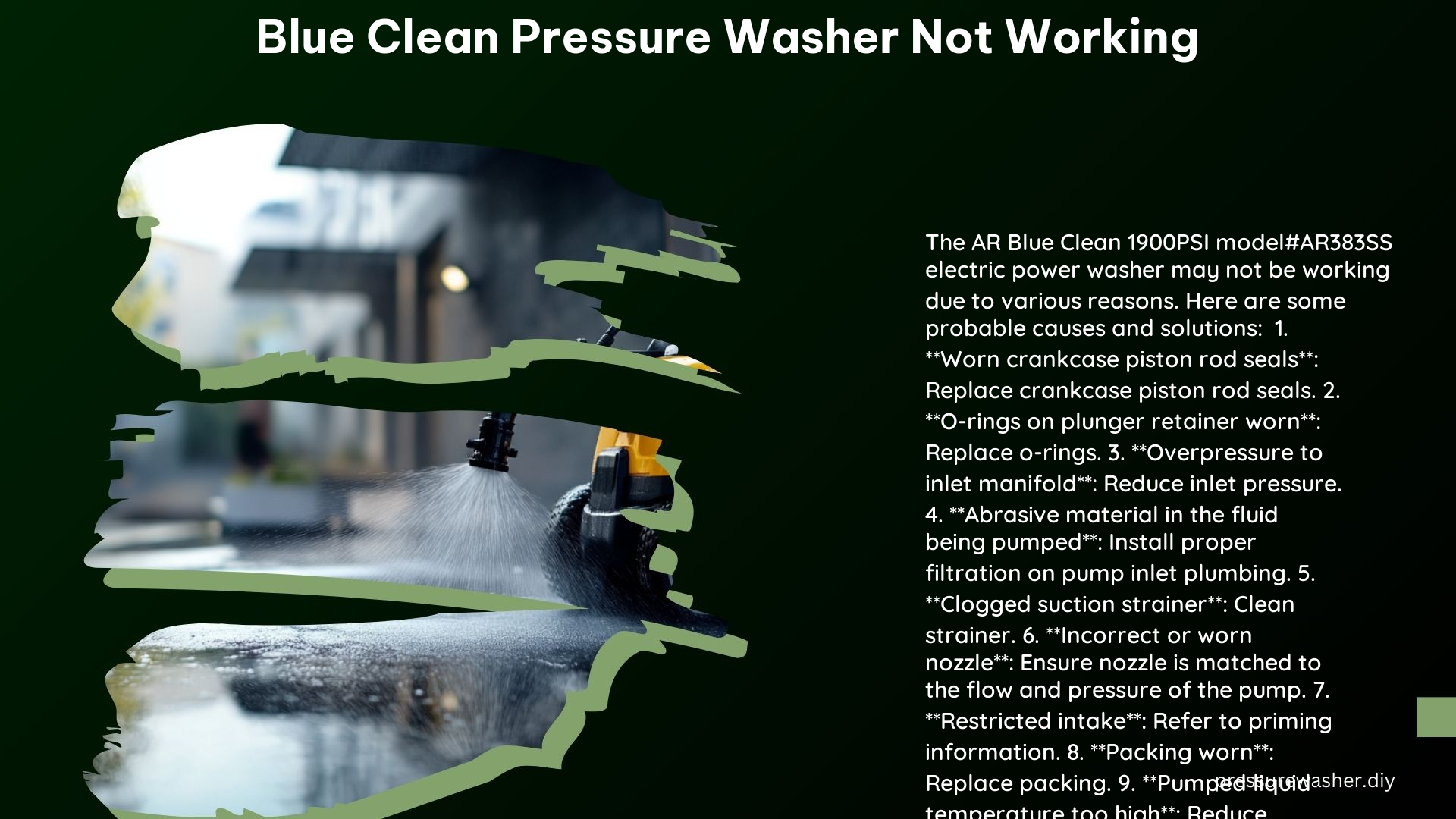If your Blue Clean pressure washer is not working, there could be several underlying issues that need to be addressed. This comprehensive guide will walk you through the most common problems and provide detailed solutions to help you get your pressure washer back in top working condition.
Leaks in the System
One of the most common issues with Blue Clean pressure washers is leaks in the system. These leaks can occur in the hoses, connections, or even the pump internals. To diagnose and fix this problem:
- Inspect the Hoses: Carefully examine the high-pressure hose and the garden hose for any cracks, holes, or other signs of damage. Replace the hose if you find any issues.
- Check the Connections: Ensure that all connections, including the garden hose, high-pressure hose, and spray gun, are securely tightened. Use a wrench to tighten any loose connections.
- Inspect the Pump: If the leaks are coming from the pump, it may be due to worn or damaged internal components, such as piston rod seals or O-rings. In this case, you may need to replace the affected parts.
No Water Flow

If your Blue Clean pressure washer is not producing any water flow, there are a few things you can check:
- Garden Hose Connection: Verify that the garden hose is properly connected to the pressure washer’s water inlet. Check for any kinks or blockages in the hose.
- High-Pressure Hose: Ensure that the high-pressure hose is securely connected to both the pressure washer and the spray gun. Look for any obstructions or damage in the hose.
- Spray Gun: Inspect the spray gun for any clogs or blockages. Try removing and cleaning the nozzle.
Electrical Issues
If your Blue Clean pressure washer is not turning on or is not receiving power, there could be an electrical issue:
- Power Cord: Ensure that the power cord is properly plugged into a functioning electrical outlet. Check for any damage or wear on the cord.
- GFCI Plug: Verify that the GFCI (Ground Fault Circuit Interrupter) plug is working correctly. Press the reset button if the GFCI has tripped.
- Motor: If the motor is not running, it may be due to a faulty switch or a problem with the internal wiring. In this case, you may need to have the pressure washer serviced by a qualified technician.
Clogged Nozzles
Clogged nozzles can significantly reduce the pressure and performance of your Blue Clean pressure washer. To clean the nozzle:
- Nozzle Cleaning: Use a nozzle cleaning tool or a small wire to carefully remove any debris or buildup from the nozzle opening.
- Nozzle Replacement: If the nozzle is severely clogged or damaged, it’s best to replace it with a new nozzle of the correct size and type.
Pump Issues
If the pump is running but not building pressure, it could be due to worn or damaged internal components:
- Piston Rod Seals: Inspect the piston rod seals for any signs of wear or damage. Replace the seals if necessary.
- O-rings: Check the O-rings in the pump for any cracks or deterioration. Replace the O-rings if they are not in good condition.
- Valves: Clean or replace any worn or damaged valves to ensure proper pump function.
Incorrect Nozzle
Using the wrong nozzle size or type can significantly impact the performance of your Blue Clean pressure washer. Ensure that the nozzle is matched to the flow and pressure specifications of your particular model.
- Nozzle Size: Refer to the manufacturer’s recommendations for the appropriate nozzle size based on your pressure washer’s flow rate and pressure.
- Nozzle Wear: If the nozzle is worn, replace it with a new nozzle of the correct size to maintain optimal performance.
Air Leaks
Air leaks in the inlet plumbing can prevent the pressure washer from building the necessary pressure. To check for air leaks:
- Inspect Connections: Examine all the connections in the inlet plumbing, including the garden hose, for any signs of damage or looseness.
- Repair or Replace: If you find any air leaks, tighten the connections or replace the affected components to eliminate the leaks.
Overpressure
If the inlet pressure to your Blue Clean pressure washer is too high, it can cause issues with the pump and overall performance. Ensure that the inlet pressure and fluid temperature are within the specified range for your model.
- Inlet Pressure: Refer to the manufacturer’s recommendations for the maximum inlet pressure your pressure washer can handle.
- Fluid Temperature: Check that the inlet water temperature is not exceeding the recommended range, as this can also lead to overpressure problems.
Clogged Suction Strainer
A clogged suction strainer can restrict water flow and prevent the pressure washer from building the necessary pressure. Regularly clean the suction strainer to maintain optimal performance.
- Strainer Cleaning: Disconnect the garden hose and remove the suction strainer. Clean any debris or buildup from the strainer using a brush or compressed air.
- Strainer Replacement: If the strainer is severely clogged or damaged, replace it with a new one.
Worn or Damaged Valves
Faulty or worn valves can also contribute to pressure issues in your Blue Clean pressure washer. Clean or replace any damaged valves to ensure proper function.
- Valve Inspection: Carefully inspect the valves, including the inlet and outlet valves, for any signs of wear, damage, or buildup.
- Valve Cleaning or Replacement: If the valves are not in good condition, clean them or replace them with new ones.
By following these detailed troubleshooting steps and addressing the specific issues, you should be able to identify and fix the problem with your Blue Clean pressure washer, restoring it to its full working condition.
Reference:
- https://www.reddit.com/r/pressurewashing/comments/11k5grk/ar_blue_clean_2050_pump_runswhines_but_no_pressure/
- https://www.youtube.com/watch?v=VL_Q_fW7R2E
- https://arblueclean.com/faq/?srsltid=AfmBOooQqLVdRhdvsqUlJPTMR9_HmtKevsBWLiPRNbI5jkdnuhZ_u5z1
- https://www.justanswer.com/small-engine/fem4o-ar-blue-clean-1900psi-model-ar383ss-electric-power.html
- https://arnorthamerica.com/services/troubleshooting/
